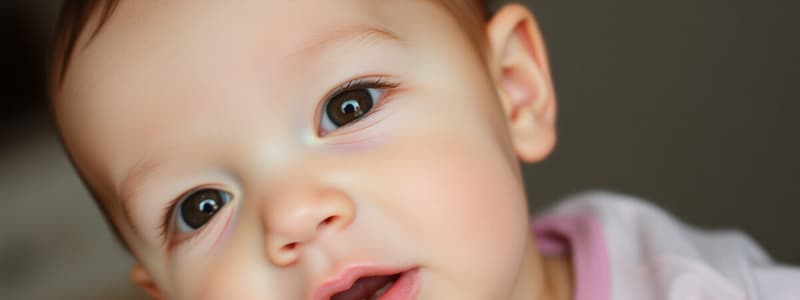Podcast
Questions and Answers
What is prosopagnosia commonly known as?
What is prosopagnosia commonly known as?
- Face recognition disorder
- Facial dyslexia
- Face blindness (correct)
- Facial agnosia
Which component is responsible for providing information about an individual?
Which component is responsible for providing information about an individual?
- Visual recognition systems
- Face recognition units (FRUs)
- Name generation
- Personal identity nodes (PINs) (correct)
What phenomenon demonstrates the importance of configural information in face recognition?
What phenomenon demonstrates the importance of configural information in face recognition?
- Object recognition theory
- Facial feature analysis
- The inversion effect (correct)
- Neural plasticity
In which situation may prosopagnosia occur?
In which situation may prosopagnosia occur?
What is the proposed model regarding face recognition?
What is the proposed model regarding face recognition?
What do infants show a preference for when exposed to face-like patterns?
What do infants show a preference for when exposed to face-like patterns?
At what age do infants show a strong preference for normal faces over negative ones?
At what age do infants show a strong preference for normal faces over negative ones?
What is one important function of facial expressions in communication?
What is one important function of facial expressions in communication?
How often do people make eye contact during conversation?
How often do people make eye contact during conversation?
What impact does face inversion have on facial recognition?
What impact does face inversion have on facial recognition?
What is the primary reason why people are good at recognizing faces?
What is the primary reason why people are good at recognizing faces?
What phenomenon explains the difficulty in recognizing odd features when a face is inverted?
What phenomenon explains the difficulty in recognizing odd features when a face is inverted?
What is the first step in the Bruce & Young model of face recognition?
What is the first step in the Bruce & Young model of face recognition?
Flashcards
Face Recognition Units (FRUs)
Face Recognition Units (FRUs)
Brain processes that identify a face as familiar.
Prosopagnosia
Prosopagnosia
Difficulty recognizing faces, but object recognition is usually fine.
Personal Identity Nodes (PINs)
Personal Identity Nodes (PINs)
Brain areas that store info about a person.
Inversion Effect
Inversion Effect
Signup and view all the flashcards
Configural Information
Configural Information
Signup and view all the flashcards
Face preference in infants
Face preference in infants
Signup and view all the flashcards
Inversion effect (faces)
Inversion effect (faces)
Signup and view all the flashcards
Facial expressions in newborns
Facial expressions in newborns
Signup and view all the flashcards
Holistic face processing
Holistic face processing
Signup and view all the flashcards
The Thatcher Effect
The Thatcher Effect
Signup and view all the flashcards
Face Recognition process
Face Recognition process
Signup and view all the flashcards
Importance of eye contact
Importance of eye contact
Signup and view all the flashcards
Infant preference for faces (experiment)
Infant preference for faces (experiment)
Signup and view all the flashcards
Study Notes
Face Preference and Recognition
- Humans exhibit a strong preference for faces (human, animal, or face-like objects).
- This preference is present from infancy.
- Valenza et al (1996): Infants (n=36) showed a longer looking time and preference for face-like patterns compared to control stimuli.
- Mondloch et al (1999): Three age groups (newborns, 6 weeks, and 12 weeks) were tested with normal and distorted faces. Newborns and 6-week-olds showed no preference, but by 12 weeks, a strong preference for normal faces emerged.
Importance of Faces
- Faces are crucial for communication due to:
- Expressions: convey emotions.
- Eye contact: establishes connection.
- Eye direction/following: communicative signal.
- Faces indicate personal identity.
Facial Expressions
- Field et al (1982): 74 babies exposed to a live model with various facial expressions, facial responses in babies were observed and correlated with those expressions. Observers could accurately interpret expressions on babies' faces. Newborns can discriminate and imitate expressions.
Eye Contact
- Eye contact is crucial in conversation (approximately 30% of the time).
- Timing (duration) is critical for effective communication.
- Turn-taking: eye contact patterns differ between listening and speaking stages.
Eye Direction
- Eye direction signals intentions and interests.
- Humans have a tendency to follow another's gaze, indicating social attention.
Facial Expertise
- Extensive exposure and the profound importance of faces contribute to excellent face-recognition abilities.
- This is taken for granted but it is remarkable.
Inversion Effect
- Difficulty recognizing inverted faces compared to upright faces ("inversion effect").
- Yin (1996): Subjects exhibited greater difficulty identifying inverted faces than inverted non-face objects, suggesting face processing is distinct from object processing. Consistent with a holistic face processing approach.
Thatcher Effect
- Thompson (1980): Difficulty of detecting local inversions (e.g., eyes, mouth) within inverted faces. Yet, the overall face is recognized.
- Explanation: Inverting a face disrupts the configural processing that is crucial for face recognition. This causes a focus to shift to feature-level processing, thus, the anomalies of the inverted features are not noticed.
Face Recognition Model (Bruce & Young, 1986)
- Structural encoding: Recognize a stimulus as a face.
- Face Recognition Units (FRUs): Recognize a face as familiar.
- Personal Identity Nodes (PINs): Associate the face with an individual.
- Name generation: Retrieve the individual's name.
Prosopagnosia
- Severe impairment in face recognition but less impairment in object recognition ("face blindness").
- Can arise from brain damage or develop without known cause.
- Symptoms and severity vary among patients.
Studying That Suits You
Use AI to generate personalized quizzes and flashcards to suit your learning preferences.




